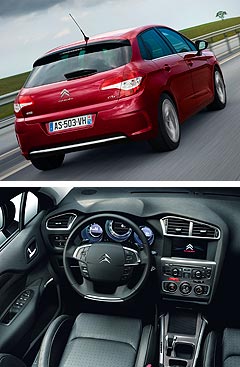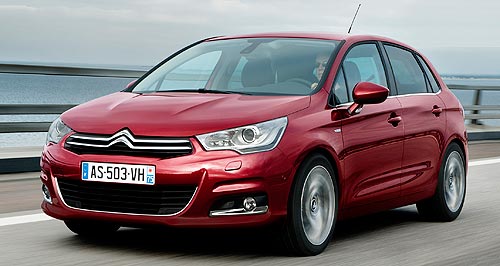Make / Model Search
Future models - Citroen - C4Citroen launches new C4 ahead of ParisC4 foreseen: Citroen’s redesigned C4 will go on sale in Australia in mid-2011. Full details and fresh images of Citroen’s new C4 emerge from its pre-Paris launch17 Sep 2010 CITROEN has issued full details and fresh images of the redesigned C4 from its global launch in Copenhagen this week, before the new small French hatchback makes its world motor show debut in Paris on September 30. The next-generation C4 is the latest in a series of fresh Citroen models to emerge recently, following this month’s Australian launch of the all-new DS3 and the redesigned C3 light hatch that goes on sale here in December. Before the C4 arrives here in mid-2011, Citroen will also release mildly facelifted versions of the C4 Picasso people-mover and the mid-size C5 range while Citroen will also stage the global launch of the all-new DS4 next year, before the new C5 and its all-new DS5 derivative arrive in 2012. Both the upgraded C5 and C4 Picasso – along with the production version of the Mitsubishi i-MiEV-based C-Zero - will be presented with the historic French brand’s new corporate grille at the Paris show. For now, the new C4 line-up, which is now being produced at the Mulhouse plant in France before going on sale across Europe by the end of this year, is headlined by new ‘e-HDi micro-hybrid’ and latest-generation idle-stop technologies, which Citroen claims will reduce CO2 emissions to only 109 grams per kilometre on some models from launch, falling to just 99g/km later. New Michelin Energy Saver tyres employed first by the new C4 are claimed to reduce CO2 emissions by more than 5g/km (as well as reducing fuel consumption by 0.2L/100kmm equating to a claimed 90 litres during the service life of the tyres) as part of the micro-hybrid package. It combines with ‘green’ materials that are said to comprise 15 per cent of the new vehicle’s construction – a record for the PSA Peugeot Citroen group. Citroen claims the C4 will bring a range of new top-end technologies to the global C-segment, including blind spot monitoring, a programmable speed limiter and cruise control, electric lumbar adjustment and a massage function for the front seats and the Citroen eTouch service, which includes a localised emergency and breakdown call system. Also new to the compact hatchback market is “customised onboard ambience”, which allows drivers to choose from between a range of colours for the instrument cluster and a range of polyphonic ringtone-like chimes, as well as the intensity of the air-conditioning. The next C4 will also be available with hill start assist, a lane departure warning system, Xenon dual-function directional headlights, parking sensors, front foglights with static cornering lighting function, and a parking space gap measurement system.  First revealed in May, the larger new C4’s exterior design is less adventurous than that of the award-winning current model, the local line-up of which has already been trimmed to just four variants as the outgoing model is now in run-out mode in Europe. First revealed in May, the larger new C4’s exterior design is less adventurous than that of the award-winning current model, the local line-up of which has already been trimmed to just four variants as the outgoing model is now in run-out mode in Europe.Citroen has now confirmed that, at least in Europe, it will be available in 10 exterior paint colours and with wheel sizes ranging between 15 and 18 inches. The new C4 measures 433 metres long (up 50mm), 1.79 metres wide (up 20mm) and 1.49 metres high (up 30mm), while the boot is said to offer best-in-class space of 408 litres. It is augmented by a large, illuminated glovebox, door compartments that can hold t.5-litre bottles, drawers under the front seats, a centre stack storage big and, on models fitted with a clutchless manual transmission (and therefore a novel new gear selector and electric parking brake), a high, wide central console with four distinct storage areas. One of them is chilled and can hold up to four small bottles, while a console under the front armrest features a 240-volt outlet and is designed to hold CD. Citroen claims the new interior will feature best-in-class materials like ‘slush skin’ for the dashboard, ‘jersey’ fabric for the roof lining and chrome detailing on the steering wheel controls, air-vents and gearshifter, setting new standards in perceived quality. Within the new dash is a new centre stack that groups the audio and climate controls with no visible joins, a new instrument cluster with three dials combining analogue and digital information, and a new steering wheel design with controls that are said to be grouped into clearly defined areas, including audio, telephone, speed limiter/cruise control and comfort. Underneath the new car is MacPherson-type front suspension, new rear suspension with a flexible transverse beam and a hydraulic steering system with an electric pump. Electronic brake-force distribution, emergency brake assist, electronic stability/traction control and six airbags will be standard on the next C4, which has already achieved a five-star EuroNCAP safety rating. The new C4’s maximum safety credentials come despite “extensive studies on weight control, during which designers looked at all possible ways of making the car lighter”. The result is a redesigned fixed-hub steering wheel that is 3.5kg lighter, laser welding of the roof and doors that saves a claimed 2kg and flow-formed wheels, saving 1.5kg. Citroen says about 20 per cent or 200kg of the vehicle’s construction is made up of plastic or polymer materials – 20 per cent of which it hopes to make from renewable materials by 2011. They include natural fibres like linen or hemp, and non-metallic recycled materials and biomaterials containing no petrochemicals. Specifically, cellulose fibre is used for the roof lining, textiles are used to make the gear lever, recycled polyamide makes up the wheel covers on base models, recycled polypropylene is used in the air intake grille support, and recycled ground glass is employed to soundproof the under-engine shield. The new C4, which has a base kerb weight of 1200kg, will be available in Europe with four HDi turbo-diesel and three petrol engines, all of them Euro 5 emissions-compliant. The Australian C4 line-up will not include entry-level diesel or petrol engines, but in Europe the range includes 90 DPFS, HDi 110 DPFS, e-HDi 110 DPFS and HDi 150 DPFS diesel engine. The petrol line-up comprises VTi 95 (70kW/135Nm) , VTi 120 (88kW/160Nm) and THP 155 (115kW/240Nm) engines, with the latter and the e-HDi 110 DPFS engines both matched with a six-speed clutchless manual gearbox and the HDi 110 DPFS and HDi 150 DPFS mated to a six-speed manual. The base VTi 120 engine will come with five-speed manual or four-speed automatic transmissions. Citroen says all diesel engines will emit less than 130g/km, while the petrol engines will emits between 140 and 162g/km.  Read more1st of June 2010  More substance, less style for Citroen's next C4Citroen’s all-new small car emerges sans the current C4’s slick stylingAll future models Alfa Romeo Alfa Romeo Abarth Abarth Alpine Alpine Alpina Alpina Audi Audi Aston Martin Aston Martin BMW BMW Bentley Bentley Chery Chery Brabham Brabham Chrysler Chrysler Chevrolet Chevrolet Cupra Cupra Citroen Citroen DS DS Dodge Dodge Fiat Fiat Ferrari Ferrari Foton Foton Ford Ford Great Wall Great Wall FPV FPV Haval Haval GWM GWM Honda Honda Holden Holden Hummer Hummer HSV HSV Infiniti Infiniti Hyundai Hyundai Jaguar Jaguar Isuzu Isuzu Kia Kia Jeep Jeep Land Rover Land Rover Lamborghini Lamborghini Lexus Lexus LDV LDV Mahindra Mahindra Lotus Lotus Mazda Mazda Maserati Maserati Mercedes-AMG Mercedes-AMG McLaren McLaren MG MG Mercedes-Benz Mercedes-Benz Mitsubishi Mitsubishi Mini Mini Opel Opel Nissan Nissan Peugeot Peugeot Pagani Pagani Proton Proton Porsche Porsche Renault Renault Ram Ram Rover Rover Rolls-Royce Rolls-Royce Skoda Skoda Saab Saab SsangYong SsangYong Smart Smart Suzuki Suzuki Subaru Subaru Toyota Toyota Tesla Tesla Volvo VolvoMotor industry news |
Click to shareCitroen modelsResearch Citroen All future models Alfa Romeo Alfa Romeo Abarth Abarth Alpine Alpine Alpina Alpina Audi Audi Aston Martin Aston Martin BMW BMW Bentley Bentley Chery Chery Brabham Brabham Chrysler Chrysler Chevrolet Chevrolet Cupra Cupra Citroen Citroen DS DS Dodge Dodge Fiat Fiat Ferrari Ferrari Foton Foton Ford Ford Great Wall Great Wall FPV FPV Haval Haval GWM GWM Honda Honda Holden Holden Hummer Hummer HSV HSV Infiniti Infiniti Hyundai Hyundai Jaguar Jaguar Isuzu Isuzu Kia Kia Jeep Jeep Land Rover Land Rover Lamborghini Lamborghini Lexus Lexus LDV LDV Mahindra Mahindra Lotus Lotus Mazda Mazda Maserati Maserati Mercedes-AMG Mercedes-AMG McLaren McLaren MG MG Mercedes-Benz Mercedes-Benz Mitsubishi Mitsubishi Mini Mini Opel Opel Nissan Nissan Peugeot Peugeot Pagani Pagani Proton Proton Porsche Porsche Renault Renault Ram Ram Rover Rover Rolls-Royce Rolls-Royce Skoda Skoda Saab Saab SsangYong SsangYong Smart Smart Suzuki Suzuki Subaru Subaru Toyota Toyota Tesla Tesla Volvo VolvoMotor industry news |











Facebook Twitter Instagram